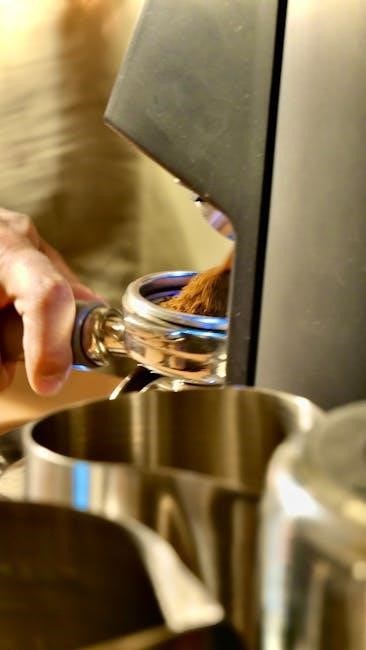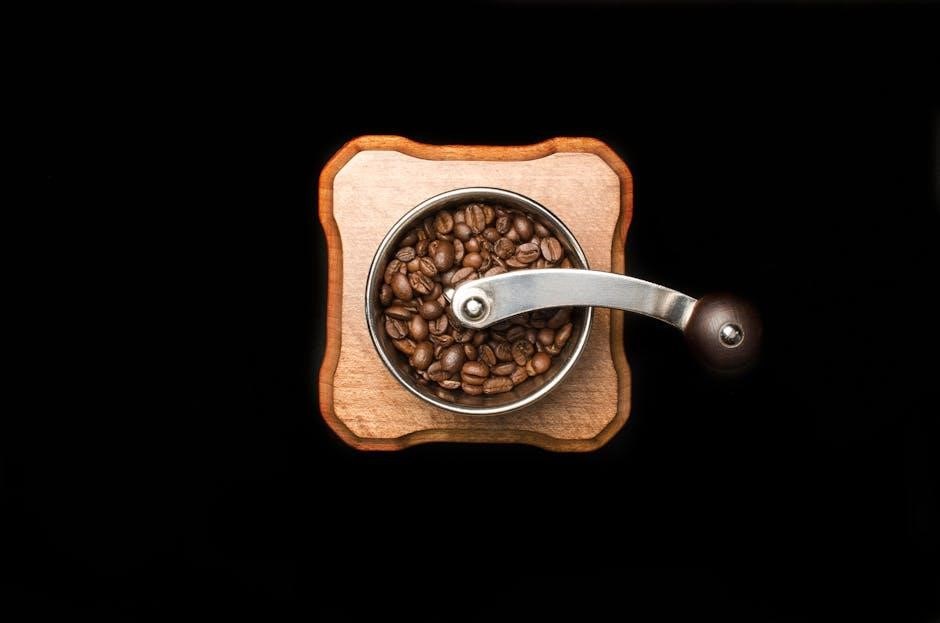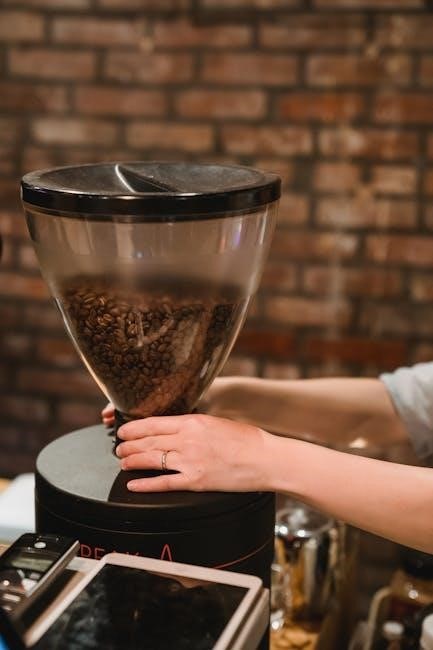Manual and electric coffee grinders offer distinct brewing experiences. Manual grinders provide a quiet, cost-effective solution, while electric grinders deliver speed and convenience, catering to different lifestyles and preferences.
Overview of Coffee Grinder Types
Coffee grinders are essential tools for coffee enthusiasts, available in two primary types: manual and electric. Manual grinders, also known as hand grinders, require physical effort to grind coffee beans. They are typically more affordable, starting at around $10-$20, and offer a quiet, tactile grinding experience. These grinders are ideal for those who value precision and consistency, as they allow for fine control over the grind size. Electric grinders, on the other hand, are powered by motors, making them faster and more convenient for daily use. They often come with additional features like preset settings and timers. Electric grinders are generally more expensive, with prices starting significantly higher than manual ones. Both types cater to different lifestyles and preferences, whether you prioritize cost, convenience, or the joy of a hands-on brewing process.
Pros and Cons of Manual Coffee Grinders
Manual grinders offer precision, affordability, and quiet operation but require effort and time. They are portable and durable but may lack speed for large quantities, suiting casual users best.
Advantages of Manual Grinders
Manual coffee grinders are highly cost-effective, with many models available for under $20, making them an excellent choice for budget-conscious coffee enthusiasts. They operate quietly, ideal for early mornings or shared living spaces, and provide a tactile, satisfying grinding experience. Manual grinders are also lightweight and portable, perfect for travel or small households. Their compact design saves kitchen space, and they require no electricity, making them eco-friendly. Additionally, manual grinders often produce consistent grinds, especially in the fine to medium range, and are less prone to overheating, which can preserve the coffee’s flavor. Many users appreciate the control they offer over the grind size, allowing for precise adjustments to suit various brewing methods. Overall, manual grinders are a durable, affordable, and user-friendly option for those who value simplicity and quality in their coffee preparation.
Disadvantages of Manual Grinders
Manual coffee grinders require physical effort and time, as grinding beans by hand can be labor-intensive, especially for larger quantities. This makes them less suitable for those in a hurry or with limited strength. Additionally, manual grinders often have smaller capacities, meaning you may need to grind multiple times for multiple servings. Achieving a consistent grind can also be challenging, as it depends on the user’s technique and endurance. Some users find the repetitive motion tedious, particularly for coarse grinds. Furthermore, cleaning manual grinders can be more cumbersome compared to electric models, as they often disassemble into multiple parts. While they are durable, the grind quality may vary depending on the model and user skill. Overall, manual grinders are less convenient for high-volume use but remain a great option for small batches and those who enjoy the manual process.

Pros and Cons of Electric Coffee Grinders
Electric coffee grinders offer speed and convenience, ideal for large batches, but are generally louder and more expensive than manual grinders. They provide consistent grinds but may lack portability and require more maintenance;
Advantages of Electric Grinders
Electric coffee grinders are known for their speed and efficiency, making them ideal for busy households. They can handle large batches of coffee beans quickly, saving time and effort. With the ability to produce consistent grind sizes, electric grinders are perfect for various brewing methods, from espresso to French press. Many models come with advanced features like timers, multiple grind settings, and automatic shut-off, enhancing convenience. They are also versatile, often doubling as spice or nut grinders. While they may be louder and more expensive than manual grinders, their ease of use and ability to deliver uniform results make them a popular choice for coffee enthusiasts. Electric grinders are a practical option for those who value speed and consistency in their daily coffee routine.
Disadvantages of Electric Grinders
Electric coffee grinders have several drawbacks that may deter some users. One of the primary disadvantages is their higher cost compared to manual grinders, especially for high-quality models. They also generate more noise during operation, which can be inconvenient in quiet environments. Additionally, electric grinders produce heat during grinding, which can potentially damage the beans and alter their flavor. Maintenance is another consideration, as they require regular cleaning and may have more complex parts to manage; Furthermore, their bulkier design takes up more storage space, and they rely on electricity, making them less portable. While electric grinders are convenient, these factors may make them less appealing to those seeking affordability, simplicity, or a travel-friendly option. Despite these drawbacks, many coffee enthusiasts find the benefits of electric grinders outweigh the disadvantages.

Key Differences Between Manual and Electric Grinders
Manual grinders are portable, quieter, and cost-effective, while electric grinders offer speed and convenience, making them suitable for different lifestyles and brewing preferences.
Cost Comparison
Manual coffee grinders are generally more affordable, with entry-level models starting at around $10-$20. Electric grinders, on the other hand, are priced higher, with basic models beginning at $50 and premium options reaching up to $500. Manual grinders offer excellent value for their price, often delivering consistent results comparable to more expensive electric grinders. For budget-conscious users, manual grinders are a cost-effective choice. However, electric grinders may justify their higher cost for those who prioritize speed and convenience. Mid-range electric grinders ($100-$300) often provide a good balance of performance and affordability, making them a popular choice for everyday use. Ultimately, the choice depends on your budget and how much you value convenience versus cost savings.
Ease of Use
Manual and electric coffee grinders differ significantly in terms of ease of use. Manual grinders require physical effort, as users must turn a handle to grind the beans. This process can be time-consuming, especially for large quantities, but it offers a tactile experience that many find satisfying. Electric grinders, on the other hand, are much faster and require minimal effort—simply add beans and press a button. They are ideal for busy individuals or those who value convenience. However, electric grinders may have more complex settings and cleaning processes. Manual grinders are often more portable and easier to clean, making them a great choice for travel or small batches. Ultimately, the choice depends on whether you prioritize convenience and speed or enjoy a hands-on, traditional grinding experience.
Noise Levels
Noise levels vary significantly between manual and electric coffee grinders. Manual grinders are generally much quieter, as they rely on manual operation without any motor noise. This makes them ideal for early mornings or shared living spaces where noise needs to be minimized. Electric grinders, while faster, produce noticeable noise due to their motorized operation. High-end electric grinders may have quieter motors, but they still tend to be louder than manual ones. For those who value a peaceful environment, manual grinders are a better choice. However, if speed and convenience are priorities, the noise of electric grinders may be a worthwhile trade-off. Ultimately, noise considerations should align with your lifestyle and daily routine, ensuring your coffee preparation complements rather than disrupts your surroundings.

Which Grinder is Right for You?
Your choice between a manual and electric coffee grinder depends on balancing lifestyle needs, budget, and desired coffee quality to ensure the best brewing experience for your daily routine.
Lifestyle Considerations
Lifestyle plays a significant role in choosing between manual and electric coffee grinders. For those who value a meditative, hands-on brewing experience and have the time to spare, manual grinders offer a tactile connection to coffee preparation. They are ideal for small batches and solo drinkers who prioritize quality and control. On the other hand, electric grinders are perfect for busy individuals seeking convenience and speed, especially when brewing for multiple people. If your mornings are rushed, an electric grinder can save precious time. Additionally, noise levels may influence your decision; manual grinders operate quietly, making them suitable for early risers or shared living spaces. Ultimately, your daily routine, patience level, and the number of people you’re brewing for will guide your choice, ensuring your grinder aligns with your unique lifestyle and preferences.
Budget and Affordability
Budget is a crucial factor when deciding between manual and electric coffee grinders. Manual grinders are generally more affordable, with entry-level models starting at around $10-$20, making them an excellent choice for those on a tight budget or new to coffee grinding. They are also a cost-effective option for casual users who don’t require high-volume grinding. Electric grinders, while more convenient, tend to be pricier, with basic models starting at $50-$100 and high-end versions costing upwards of $200. However, some manual grinders offer impressive durability and consistency, often rivaling lower-priced electric models. For budget-conscious individuals, manual grinders provide a practical and economical solution without compromising on coffee quality. Conversely, those willing to invest in convenience and speed may find electric grinders worth the extra cost. Balancing affordability with functionality is key to making the right choice for your wallet and needs.
Coffee Quality and Consistency
When it comes to coffee quality and consistency, both manual and electric grinders have their strengths. Manual grinders often provide exceptional control over grind size, allowing for a precise and even extraction, which is ideal for specialty coffee enthusiasts. The tactile process ensures minimal heat generation, preserving the coffee beans’ delicate flavors. On the other hand, high-quality electric grinders, especially those with burr grinding mechanisms, deliver consistent results with minimal effort. However, blade-based electric grinders can generate heat, potentially affecting flavor. Manual grinders excel in producing a uniform grind, while electric grinders offer speed and efficiency, especially for larger quantities. Ultimately, the choice depends on the user’s emphasis: manual grinders for artisanal control and electric grinders for convenience without compromising quality. Both options can achieve excellent results when used correctly, making coffee quality a matter of personal preference and brewing habits.

Popular Manual Coffee Grinder Models
Top-rated manual grinders include the KRUPS Coffee Grinder and Hario Mini Mill, known for their consistent grinds, durability, and ease of use, perfect for coffee enthusiasts seeking quality and portability.
Top-Rated Manual Grinders in 2025
In 2025, the KRUPS Coffee Grinder and Hario Mini Mill remain top choices for coffee enthusiasts. The JavaPresse Manual Coffee Grinder is praised for its ceramic burrs and effortless grinding. The Hario Mini Mill stands out for its sleek design and adjustable grind settings. The Timemore Chestnut C2 is another favorite, offering a large capacity and consistent grinds. These models are celebrated for their durability, portability, and ability to deliver precise control over coffee grounds. They cater to both casual drinkers and aficionados, offering a cost-effective alternative to electric grinders. Their compact designs make them ideal for small kitchens or travel. With their reputation for quality and affordability, these manual grinders continue to dominate the market, providing an excellent balance between performance and value for coffee lovers worldwide.

Popular Electric Coffee Grinder Models
The Breville Smart Grinder Pro and Baratza Encore are top-rated electric coffee grinders in 2025, offering precise grind control, high-speed burrs, and programmable settings for consistent, professional-quality brews at home.
Top-Rated Electric Grinders in 2025
In 2025, the Breville Smart Grinder Pro and Baratza Encore remain top choices among coffee enthusiasts. The Breville model boasts 60 precise grind settings and a programmable interface, making it ideal for consistent brewing. Meanwhile, the Baratza Encore is praised for its durability and user-friendly design, offering 40 grind settings for versatility. Both grinders feature high-quality burrs that ensure even extraction and minimize heat buildup, preserving the coffee’s flavor. Other notable electric grinders include the Cuisinart DBM-8 and OXO Brew, which offer excellent value for their price. These models are preferred by those who prioritize speed and convenience without compromising on coffee quality. With advanced features like LED displays and automatic shut-off, these electric grinders cater to both casual drinkers and coffee connoisseurs alike, providing a seamless and efficient grinding experience.

Final Thoughts on Manual vs. Electric Coffee Grinders
Choosing between manual and electric coffee grinders ultimately depends on your lifestyle, budget, and coffee preferences. Manual grinders offer a tactile, cost-effective experience with quieter operation, making them ideal for coffee purists and travelers. Electric grinders, while pricier, provide speed, convenience, and consistency, perfect for busy households or those seeking efficiency. Both options deliver excellent results, but your decision should hinge on what matters most—whether it’s affordability, ease of use, or the joy of the grinding process. By considering these factors, you can select the grinder that best aligns with your coffee journey, ensuring every brew is tailored to your taste and preferences.